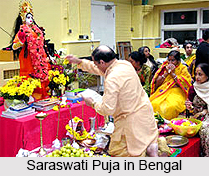 Vasant Panchami or Basant Panchami is observed by people of many castes including Hindus, Sikhs and Sufis. The Hindus observe the day by celebrating Saraswati Puja; Sufi Basant is observed in Sufi shrines; and people in the Punjab region observes this day by flying kites. The name Vasant Panchami has an etymological meaning. Vasant means "spring" and Panchami means "the fifth day." Therefore, Vasant Panchami falls on the fifth day of spring.
Vasant Panchami or Basant Panchami is observed by people of many castes including Hindus, Sikhs and Sufis. The Hindus observe the day by celebrating Saraswati Puja; Sufi Basant is observed in Sufi shrines; and people in the Punjab region observes this day by flying kites. The name Vasant Panchami has an etymological meaning. Vasant means "spring" and Panchami means "the fifth day." Therefore, Vasant Panchami falls on the fifth day of spring.
This day is observed in honour of Saraswati, the goddess of knowledge, wisdom, art and music, since this day, is considered as her birthday. The Magh Sud, which is the 5th day of the bright fortnight of the lunar month of Magh, (January to February) is the day of Vasant Panchami. Goddess Saraswati is worshipped for spiritual enlightenment, the greatest wealth to man. The Goddess is a favorite of religious and spiritual leaders. Hindu folklore puts the Learned on a higher pedestal than even the king. The colour yellow is given special importance on Vasant Panchami. On this day, Saraswati is dressed in yellow garments and worshipped and even people prefer to wear yellow clothes on this holy day. The lady of the house sets the trend for the festive mood by wearing yellow saree with zari and gotta. Sweetmeats of yellowish hues are distributed among relations and friends.
Vasant Panchami and Saraswati Puja
Goddess Saraswati is quietly worshipped and no important temples are dedicated to her. She is not a deity of communal adoration. However, an elaborate puja, with sandalwood, ghee, joss sticks, and incense is performed to the sound of shlokas, conch shells, and drums. Some people feed Brahmins some perform Pitri-Tarpan (ancestor worship). Many also worship Kamadeva, the god of love on this day. Children are taught their first words on this day, as an auspicious beginning to learning. Schools, colleges also organize special worship of Saraswati.
 Interestingly the story of Saraswati Puja is related to the Brahma Vaivarta Purana. Sri Krishna granted Saraswati a boon that she too will be worshipped on Vasant Panchami. After performing the sacred bathing, a kalasha is established. After having worshipped Ganesh, the Sun, Vishnu and Shiva, Saraswati is worshipped. After that coloured powder is thrown into the air. This is the manner of observance of praying to Goddess Saraswati on Vasant Panchami.
Interestingly the story of Saraswati Puja is related to the Brahma Vaivarta Purana. Sri Krishna granted Saraswati a boon that she too will be worshipped on Vasant Panchami. After performing the sacred bathing, a kalasha is established. After having worshipped Ganesh, the Sun, Vishnu and Shiva, Saraswati is worshipped. After that coloured powder is thrown into the air. This is the manner of observance of praying to Goddess Saraswati on Vasant Panchami.
Celebration of Vasant Panchami in Punjab
In Punjab, Vasant Panchami is known as Basant Panchami. A ritual not connected to the worship but equally essential to the celebration is that of flying kites on this day. The days leading to the festival represent busy times for kite makers for the usually clear blue skies that tend to be filled with kites of all colors. In the past, Maharaja Ranjit Singh had introduced the tradition of kite flying on Basant over two hundred years ago, which became popular in the Punjab region. Kite festivals are held in cities such as Firozpur, where children generally fly kites to mark the auspicious occasion.
Celebration of Vasant Panchami in Rajasthan
People in Rajasthan celebrate this day by wearing yellow coloured dresses, eating different types of sweets and display yellow coloured flowers at their houses. In Rajasthan, it is customary for people to wear jasmine garlands.
Celebration of Vasant Panchami in Bengal
In Bengal, it is called the Saraswati Puja and over here, the Hindu temples are full of activities on this day. People worship her with flowers, especially with basaka, and decorations are made chiefly with `Ganda` to represent the season - Vasanta. Even here, all ladies attire themselves in yellow and worship her. Vasant panchami celebrations are free from boisterous processions and street scenes. However, in Bengal her clay images are taken in procession and are immersed in rivers or tanks.





